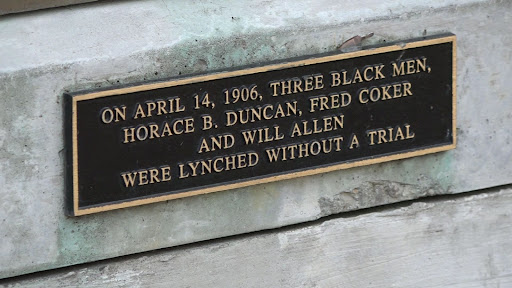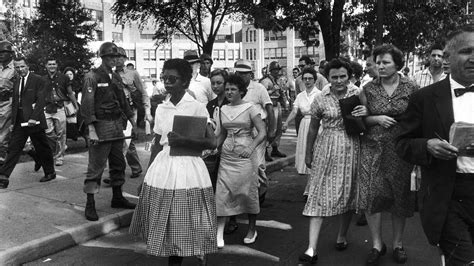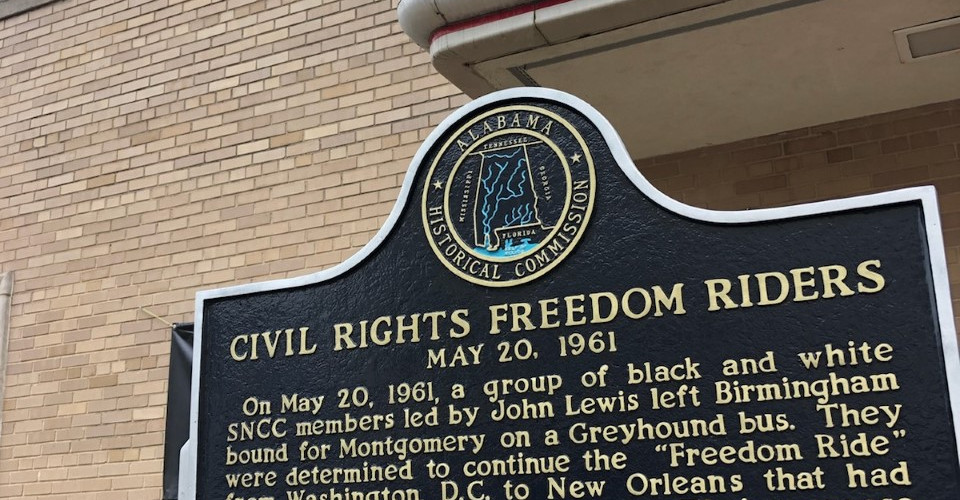Peaking Behind the Curtain: Tulsa Part 2
- Spencer
- Oct 11, 2021
- 7 min read
Updated: Aug 5, 2024
After one year on the road (we were here in October, 2018), one of the most impactful aspects of our travels has been the opportunity to not only learn about the deep wrinkles in America's history but to visit many of the sights where these consequential events unfolded. Seeing the actual street corners, the battlefields, the bus stops, the lunch counters, and school hallways has lifted these stories off the flat pages of history books and given them new life.
Sometimes we seek out these landmarks, and sometime they find us. One pleasant afternoon, as we strolled the streets of Tulsa we came across a historical marker that wiped the smiles right off our faces.

For you see, we had strolled into the Greenwood district. This location meant nothing to us at first, but once we read this marker, the significance of this area left us speechless. For this was the sight of the 1921 Tulsa Massacre. The enormity of the event staggers the imagination. 56 years after the end of the Civil War, open warfare actually broke out on these streets between groups of whites and blacks. There are numerous books and movies about this horrific event, so for the sake of brevity I shall only summarize.
At the time, Tulsa had a thriving black community. It was known as the Greenwood District, the "Black Wall Street". Just how thriving was it?

I found this description of Greenwood at Blackpast.org:
"According to 1920 city directories, there were 108 black business establishments, including 2 newspapers, 41 groceries and meat markets, 30 cafes and restaurants. There were also offices for 33 professionals, including 15 physicians and attorneys in Tulsa’s African American community serving the nearly 10,000 residents. In addition, Deep Greenwood had clothing stores, funeral parlors, billiard halls, hotels, barbershops, hairdressers, shoemakers, tailors, nightclubs, and two movie theaters. Because most white establishments refused to serve African Americans, black entrepreneurs held a captive market rich in pent-up demand.
By 1920, the black “Wall Street” also had twenty-two churches and was a center for jazz and blues music. It was the place where a young Count Basie first encountered big-band jazz. The schools in Greenwood were described as exceptional compared to those in the “white” areas of town. Deep Greenwood, as it was now often called, was further advanced economically than some of the white areas of Tulsa."
Based upon what we've seen in other areas of the country, the competition probably began to grow fierce between the city's bifurcated economies. White business owners began to grow covetous of the success of these "up-starts". Greed, mixed with deep-seeded mistrust, fear and misunderstanding, along with a sensationalistic press eager to "create" the news instead of only report it, and you have an over-stuffed powder keg ready to explode.
And sadly, explode it did. On the morning of May 30, 1921, a seemingly small event set off a devastating chain reaction. A young black man named Dick Rowland was riding in an elevator with a young white woman named Sarah Page. As the elevator doors opened, Sarah Page let out a scream as Dick Rowland ran from the car. From my brief research, it is unclear what actually occurred but Sarah Page never pressed charges. Observers at the scene began circulating salacious stories which became more exaggerated with each telling. The following day the Tulsa Tribune published these rumors as fact, whipping the public into a feeding frenzy.

Gangs of armed whites gathered at the courthouse where Dick Rowland was being held for questioning. The sheriff and his men barricaded the top floor to protect the prisoner. Word quickly spread through the Black community and they turned out (many of whom were WWI vets) to prevent the lynching of the young man. No one knows who shot first, but once the smoke had cleared, sixteen hours later, 35 city blocks lay in charred ruins, more than 800 people were treated for injuries and as many as 300 people may have died.


It is chilling to think about the number of Black (American) citizens that lost their businesses, their homes, and perhaps even loved ones. The countless lives that were shattered along with the generational scars it left behind is something I can't even wrap my head nor my heart around. Mistrust, fear, and manipulation played havoc with human emotions. Sadly we are not immune from it even today.
This story reminded of a verse I came across in the Book of Job: "true wisdom has two sides". I often forget this. It is easy for people to fall victim to those who yell the loudest. They are the ones who offer the easiest and quickest answers. They relish in distilling complex problems into overly simplistic solutions. "Us here vs. them over there", or "black vs. white", or "male vs. female", or "rich vs. poor". I also see it happening again as sides are being drawn on the issue of "vaxxed vs. unvaxxed". Once teams are chosen, violence can't be far behind. The depths of brutality at which a fearful heart can sink is simply terrifying. And although there is a spiritual solution found in the powerful and transforming love of God, a more practical solution may be in giving every one, whether Prince or Pauper, an uncensored voice in the marketplace of ideas. And if we all followed the advise of James, the brother of Jesus: "Everyone should be quick to listen, slow to speak and slow to become angry"; perhaps then our country could begin to heal. Speaking from experience, this advise that much easier to give than to practice.
“With the first link, the chain is forged.
The first speech censured, the first thought forbidden,
the first freedom denied, chains us all irrevocably..
The first time any [person's] freedom is trodden on,
we're all damaged.”
-Captain Jean-Luc Picard

Before leaving for Oklahoma City, we visited a few other interesting sights in and around Tulsa.
Oral Roberts University:

We enjoy walking around the campuses of the various universities we've come across in our travels. And this campus did not disappoint. The campus of ORU is very beautiful. But our real motivation was to come and see the 60' bronze sculpture named Praying Hands. The sculpture was cast in 450 pieces and assembled on site. It is reportedly one of the largest cast bronzes in the world!



A World Trade Center right here in Tulsa:

This Tulsa skyscraper, built in 1976, bears an uncanny resemblance to the Twin Towers of New York City and the reason is, this building was designed by Minoru Yamaski & Associates, the same architects who designed the WTC! Built by the Williams Companies, it is about half the size of the WTC tower and was the tallest building in the state for over thirty years. The company’s President John Williams and some of his staff had visited the actual World Trade Center on September 10, 2001, just one day before the Towers were destroyed.
TULSA'S GOLDEN DRILLER:
Standing watch over the Tulsa Expo Center is a 65' statue paying hommage to the oil men of Tulsa and their contribution to the city's economic development. It's the sixth tallest statue in the United States!


BARNSDALL, OK: The World’s Only Main Street Oil Well!
About 40 minutes north of Tulsa sits the small depressed little town of Barnsdall.

Oil was discovered here back when tumbleweeds roamed the land. Back before Oklahoma was even a state. In the 1890's, the Barnsdall Oil Company negotiated a lease with the Osage Nation. Oil wells sprouted up like ears of corn in a farmer's field. Decades later, as the basin began to run dry, the derricks were gradually disassembled.
Today, all that's left is this lonely flat-head pump. The well was dug in 1914 and remained in use until the early 1960's. It faithfully pumped out the "black-gold" at a rate of about 8-10 barrels a day.


I'm sure many of you have the same question I did, and even after searching the Internet I was unable to find the answer to why city planners didn't just move the road over a few feet?! And, yes, we drove over 40 minutes just to see this!

Bartlesville: Price Tower
If you're going to Barnsdall, you might as well travel about 20 miles further north to Bartlesville and visit Price Tower.

The Price Tower is a spectacular Frank Lloyd Wright designed building of copper and concrete and dominates this town's humble skyline.

The tower was built by Mr. Wright in 1956 for Harold C. Price as the corporate headquarters for his pipeline construction company. While Mr. Price originally envisioned a traditional rectangular building, Frank convinced him (he usually got what he wanted) that it would be more economical to build high rather than broad.

Wright was delighted to have the opportunity to build his (only) skyscraper on the expansive plains of Oklahoma, and he nicknamed the building “The Tree that Escaped the Crowded Forest”. As was Frank's style, he also designed all the furnishing and art work along with the motif on the interior.


Here are a few shots of the interior.



The19 story office building has gone through a series of refurbishing since its creation and is now being used as an upscale hotel and art center. If you are so interested, you can read some of its customer's reviews by clicking here.
But don't leave Bartlesville, yet! There are still a few more interesting things to see here:
Bartlesville Civic Center:
If you are Frank Lloyd Wright enthusiasts, you'll enjoy visiting the Civic Center designed by his Son-In-Law (and protege) William Wesley Peters. Many of the ideas and concepts espoused by Wright are found throughout this building.




Smooth curves and rounded lines make a statement that this is truly a unique building.
OKLAHOMA'S FIRST OIL WELL:
And lastly, Bartlesville is also the location of the first oil derrick drilled in the state of Oklahoma. The Nellie Johnstone No. 1 (named after the founder's daughter) was built in 1897 and abandoned in 1964.



This finishes up our time in Tulsa. Although not a city I would choose to live in, it was fun to visit. It deepened our knowledge of race relations, America's westward expansion, and the impact the discovery of oil has on a region.


Lastly, I wanted to post a banner we came across that made me chuckle. Given it was election season, I assume "Kevin" is probably a politician. But if not, the firm of Stitt & Hern has a message for Kevins the world over.


From here, we are traveling to Oklahoma City to visit our niece and her husband, and to see what further adventures await us!




























Nice write up, thoughtfully composed. And I learned something - didn’t know Jesus had a brother! Talk about sibling rivalry potential. 😆
I love the history lessons and the amazing historic photos you find to share. Not sure I will ever visit OK but it is fun reading about your adventures. Thank you!